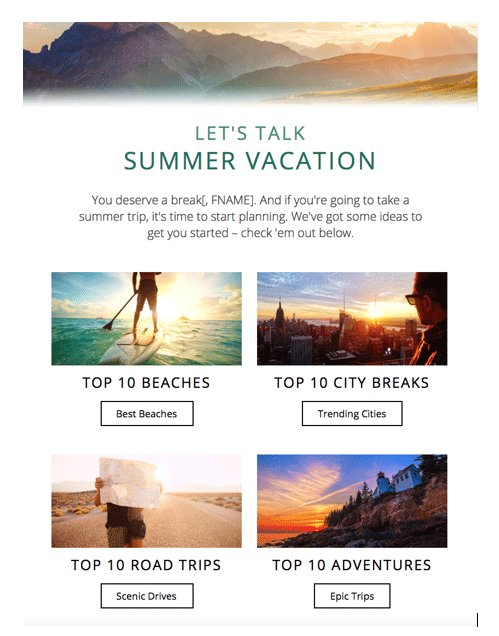Industry experts know that content marketing has many benefits for brands. Not only can a good content marketing program help increase brand awareness and improve your reputation, but it can also drive customer engagement and increase revenue.
Building an email content marketing program requires a very different strategy from traditional conversion-focused programs. To start, the focus should be on delivering high engagement metrics - like open and click through rates - rather than purely conversion metrics.
The Marriott Rewards Destinations email program is a good example of a successful content marketing email program. The hotel company wanted to inspire members to travel more by offering helpful travel tips and other relevant content via email. By using five simple tactics: Tease, Target, Teach, Test and Track, Marriott saw impressive results: higher engagement metrics across the board. Here's a look at what they did:
TEASE
Write both your subject line and body copy in a way that teases the topic of your content. Teasing the content means giving just enough information to spark subscriber interest and drive the open or click through. Give them a reason to open and click, but make sure you can deliver on the promise. The goal of this email program is to entice subscribers to open and click through to your site.
What does this look like? In your subject line, tease the email content inside to encourage the open. And once a subscriber has opened, tease them with the content that drives click-throughs. It's important to keep it simple and be able to actually deliver on the promise you've made.
For example, Marriott found that their most effective subject line, "Re: Your Summer Vacation," which teased information about vacation ideas, yielded a 20 percent higher open rate than the average. And the campaign's most engaging body content -- which drove a 35 percent higher response rate than the average -- included simple headlines along with clickable call-to-action buttons.
TARGET
The more you can personalize content to your reader, the higher engagement you'll get. With this in mind, use what you know about your customers to personalize email content accordingly. A customer who has booked a trip to Miami within the next month, for example, is more likely to engage with an email about tips and recommendations in Miami rather than advice for ski trips.
Knowing this, Marriott implemented an "Upcoming Trip" module for all subscribers who had a booked a trip within 30 days from email launch. The emails offered content specific to each subscriber's upcoming trip. Unsurprisingly, the "Upcoming Trip" module is the biggest engagement driver among subscribers who receive it.
TEACH
Informative marketing content always performs well. That means content that includes tips, tricks and other information that the subscriber may not already know. Not only does this illustrate your brand's expertise in the industry, but it also increases engagement as subscribers are interested in learning more.
For example, Marriott dedicated an entire email campaign to travel hacks, which covered topics like how to find cheaper flights or the best time to travel to Australia. This campaign, which included strictly informative content, generated a 6 percent higher engagement rate than the 12-month average.
The most informative content comes with another perk: it turns your content into a viral marketing tool. When subscribers learn a new piece of information, they're likely to repeat it to friends and family. And when asked for the source of their information, they'll hopefully site your brand.
TEST
Don't just guess at which subject line will maximize email open rates or what layout will drive the most click-throughs. Instead, test different options and optimize over time. That way you can find the combination of subject line, layout, images and body copy that drives the most conversions -- and you may be surprised by what combinations work best.
Marriott found success by testing their highest-performing layout (a 2-column style with simple imagery, headline and CTA) against a new carousel approach that was more compelling visually and by streamlining the content. Marriott found that was that the carousel's engagement was 9.5 percent higher while the conversion rate for the original layout was 0.9 percent higher. Even with the lower conversion rate on the carousel, the significant increase in clicks made the carousel approach more effective.
TRACK
Last, remember to always track your results. This is certainly not new advice for seasoned email marketers, but it's an important one to remember -- particularly when your end goal is to drive engagement. Not only will constant tracking help you present your case for the success of your program, but it will also give you the ability to see what content drives the most engagement, which helps you optimize the campaign moving forward.
For example, you might find that clicks decrease as subscribers get further down the page. Or that one topic performs particularly well compared to others. Through tracking, Marriott found that content about beaches always outperformed ski-related content. In fact, the top four most-clicked articles in January involved beach content and imagery, and accounted for over half (55 percent) of all clicks. The brand then optimized their campaigns accordingly.
Early on in the year is an ideal time to regroup and implement new strategies for boosting engagement with your email marketing program. Subscribers are coming down from a spending spree during the holidays, and less likely to engage with run-of-the-mill emails. Marketers know that one of the of the best ways to improve engagement is through content marketing programs and if you follow these 5 Ts, you're well on your way to success.
